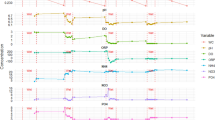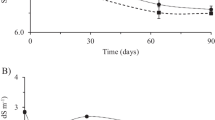Abstract
Contamination due to improper disposal of oilfield drilling waste is a serious environmental problem all over the world. This study used bench-scale experimental columns to investigate the effectiveness of combining soil vapor extraction (SVE) with bioremediation (bioaugmentation plus biostimulation) in treating drilling waste from onshore oil wells. The drilling waste used in this study was heavily contaminated with a total petroleum hydrocarbon (TPH) concentration of 2.5 × 104 mg/kg. After 154 h of SVE operation, the TPH concentrations decreased by 4.7–23.6 %, and continuous SVE operation did not significantly reduce the concentration of residual contaminants. Then, microbial consortium and inorganic nutrients (urea and K2HPO4) were employed further to enhance bioremediation, and after 216 h of bioremediation and SVE, 70 % of the residual TPH was removed. Bioremediation enhanced the overall pollutant removal efficiency by fully degrading low volatile compounds and transforming them into more volatile compounds which were extracted by SVE. Results from GC-MS analysis corroborated TPH concentration data showing the occurrence of biotransformation during SVE and bioremediation treatment. Overall, this study demonstrates that SVE combined with bioremediation is an effective technique for handling petroleum drilling waste.





Similar content being viewed by others
References
Albergaria, J. T., Alvim-Ferraz Mda, C., & Delerue-Matos, C. (2008). Soil vapor extraction in sandy soils: Influence of airflow rate. Chemosphere, 73, 1557–1561.
Albergaria, J. T., Alvim-Ferraz Mda, M., & Delerue-Matos, C. (2012). Remediation of sandy soils contaminated with hydrocarbons and halogenated hydrocarbons by soil vapour extraction. Journal of Environmental Management, 104, 195–201.
Albergaria, J. T., da Conceicao, M., Alvim-Ferraz, M., & Delerue-Matos, C. (2006). Remediation efficiency of vapour extraction of sandy soils contaminated with cyclohexane: Influence of air flow rate, water and natural organic matter content. Environmental Pollution, 143, 146–152.
Alvarez, P. J., & Illman, W. A. (2005). Bioremediation and Natural Attenuation: Process Fundamentals and Mathematical Models, Hoboken, NJ. USA: Wiley-Interscience.
Alvim-Ferraz, M.C.M., Albergaria, J.T., Delerue-Matos, C., 2006a. Soil remediation time to achieve clean-up goals I: Influence of soil water content. Chemosphere 62, 853–860
Alvim-Ferraz, M.d.C.M., Albergaria, J.T., Delerue-Matos, C., 2006b. Soil remediation time to achieve clean-up goals II: Influence of natural organic matter and water contents. Chemosphere 64, 817–825
API (2000). Overview of Exploration and Production Waste Volumes and Waste Management Practices in the United States. Washington, DC: American Petroleum Institute.
Bakke, T., Klungsøyr, J., & Sanni, S. (2013). Environmental impacts of produced water and drilling waste discharges from the Norwegian offshore petroleum industry. Marine Environmental Research, 92, 154–169.
Ball, A. S., Stewart, R. J., & Schliephake, K. (2012). A review of the current options for the treatment and safe disposal of drill cuttings. Waste Management & Research, 30, 457–473.
Breuer, E., Stevenson, A. G., Howe, J. A., Carroll, J., & Shimmield, G. B. (2004). Drill cutting accumulations in the Northern and Central North Sea: a review of environmental interactions and chemical fate. Marine Pollution Bulletin, 48, 12–25.
Cai, B., Ma, J., Yan, G., Dai, X., Li, M., & Guo, S. (2016). Comparison of phytoremediation, bioaugmentation and natural attenuation for remediating saline soil contaminated by heavy crude oil. Biochemical Engineering Journal, 112, 170–177.
Cameotra, S. S., & Bollag, J. M. (2003). Biosurfactant-enhanced bioremediation of polycyclic aromatic hydrocarbons. Critical Reviews in Environmental Science and Technology, 33, 111–126.
Dong, X., & Cai, M. (2011). System identification manual of common bacteria (Second Edition). Beijing, China: Science Press.
El Fantroussi, S., & Agathos, S. N. (2005). Is bioaugmentation a feasible strategy for pollutant removal and site remediation? Current Opinion in Microbiology, 8, 268–275.
EPA, 2001. Development of Recommendations and Methods to Support Assessment of Soil Venting Performance and Closure
Holt, J. G. (1994). Bergey’s Manual of Determinative Bacteriology. Baltimore, MD, USA: Williams & Wilkins.
Hosokawa, R., Nagai, M., Morikawa, M., & Okuyama, H. (2009). Autochthonous bioaugmentation and its possible application to oil spills. World Journal of Microbiology & Biotechnology, 25, 1519–1528.
Hu, G., Li, J., & Zeng, G. (2013). Recent development in the treatment of oily sludge from petroleum industry: A review. Journal of Hazardous Materials, 261, 470–490.
Lin, S. C., Minton, M. A., Sharma, M. M., & Georgiou, G. (1994). Structural and immunological characterization of a biosurfactant produced by Bacillus licheniformis JF-2. Applied and Environmental Microbiology, 60, 31–38.
Lu, Y., Fan, W., Yang, Y.S., Du, X.Q., Zhang, G.X., 2013. Mathematical Modeling of Differentiation Processes in Porous Media During Soil Vapor Extraction (SVE) Remediation of Contaminated Soil/Water. Water Air and Soil Pollution 224
Ma, J., Yan, G., Ma, W., Cheng, C., Wang, Q., & Guo, S. (2015). Isolation and characterization of oil-degrading microorganisms for bench-scale evaluations of autochthonous bioaugmentation for soil remediation. Water, Air, and Soil Pollution, 226, 1–10.
Ma, J., Yang, Y., Dai, X., Chen, Y., Deng, H., Zhou, H., Guo, S., & Yan, G. (2016). Effects of adding bulking agent, inorganic nutrient and microbial inocula on biopile treatment for oil-field drilling waste. Chemosphere, 150, 17–23.
Magalhaes, S. M. C., Ferreira Jorge, R. M., & Castro, P. M. L. (2009). Investigations into the application of a combination of bioventing and biotrickling filter technologies for soil decontamination processes-A transition regime between bioventing and soil vapour extraction. Journal of Hazardous Materials, 170, 711–715.
MEP-China, 1996. Water quality-Determination of petroleum oil,animal and vegetable oils-Infrared photometric method (GB/T 16488–1996). Chinese Ministry of Environmental Protection
Qin, C., Zhao, Y., Zheng, W., & Li, Y. (2010). Study on influencing factors on removal of chlorobenzene from unsaturated zone by soil vapor extraction. Journal of Hazardous Materials, 176, 294–299.
Rahbeh, M. E., & Mohtar, R. H. (2007). Application of multiphase transport models to field remediation by air sparging and soil vapor extraction. Journal of Hazardous Materials, 143, 156–170.
Singer, A. C., van der Gast, C. J., & Thompson, I. P. (2005). Perspectives and vision for strain selection in bioaugmentation. Trends in Biotechnology, 23, 74–77.
Soares, A. A., Albergaria, J. T., Domingues, V. F., Alvim-FerrazMda, M., & Delerue-Matos, C. (2010). Remediation of soils combining soil vapor extraction and bioremediation: Benzene. Chemosphere, 80, 823–828.
Soares, A. A., Pinho, M. T., Albergaria, J. T., Domingues, V., Alvim-Ferraz Mda, M., De Marco, P., & Delerue-Matos, C. (2012). Sequential Application of Soil Vapor Extraction and Bioremediation Processes for the Remediation of Ethylbenzene-Contaminated Soils. Water, Air, and Soil Pollution, 223, 2601–2609.
Souza, E. C., Vessoni-Penna, T. C., & de Souza Oliveira, R. P. (2014). Biosurfactant-enhanced hydrocarbon bioremediation: An overview. International Biodeterioration & Biodegradation, 89, 88–94.
Swaranjit Singh, C., & Makkar, R. S. (2010). Biosurfactant-enhanced bioremediation of hydrophobic pollutants. Pure & Applied Chemistry, 82, 97–116.
Thome, A., Reginatto, C., Cecchin, I., Colla, L. M. (2014). Bioventing in a Residual Clayey Soil Contaminated with a Blend of Biodiesel and Diesel Oil. Journal of Environmental Engineering. doi:10.1061/(asce)ee.1943-7870.0000863.
Thompson, I. P., van der Gast, C. J., Ciric, L., & Singer, A. C. (2005). Bioaugmentation for bioremediation: the challenge of strain selection. Environmental Microbiology, 7, 909–915.
Tyagi, M., da Fonseca, M. M., & de Carvalho, C. C. R. (2011). Bioaugmentation and biostimulation strategies to improve the effectiveness of bioremediation processes. Biodegradation, 22, 231–241.
Van Thinh, N., Zhao, L., & Zytner, R. G. (2013). Three-dimensional numerical model for soil vapor extraction. Journal of Contaminant Hydrology, 147, 82–95.
Yan, G., Ma, W., Chen, C., Wang, Q., Guo, S., Ma, J., 2016. Combinations of Surfactant Flushing and Bioremediation for Removing Fuel Hydrocarbons from Contaminated Soils. CLEAN – Soil, Air, Water doi: 10.1002/clen.201500571
Acknowledgments
This study was supported by Science Foundation of China University of Petroleum-Beijing (2462014YJRC016) and National Natural Science Foundation of China (21407180 and U1462201).
Author information
Authors and Affiliations
Corresponding author
Ethics declarations
Conflict of Interests
The authors declare no conflict of interest.
Rights and permissions
About this article
Cite this article
Ma, J., Yang, Y., Dai, X. et al. Bioremediation Enhances the Pollutant Removal Efficiency of Soil Vapor Extraction (SVE) in Treating Petroleum Drilling Waste. Water Air Soil Pollut 227, 465 (2016). https://doi.org/10.1007/s11270-016-3109-3
Received:
Accepted:
Published:
DOI: https://doi.org/10.1007/s11270-016-3109-3




